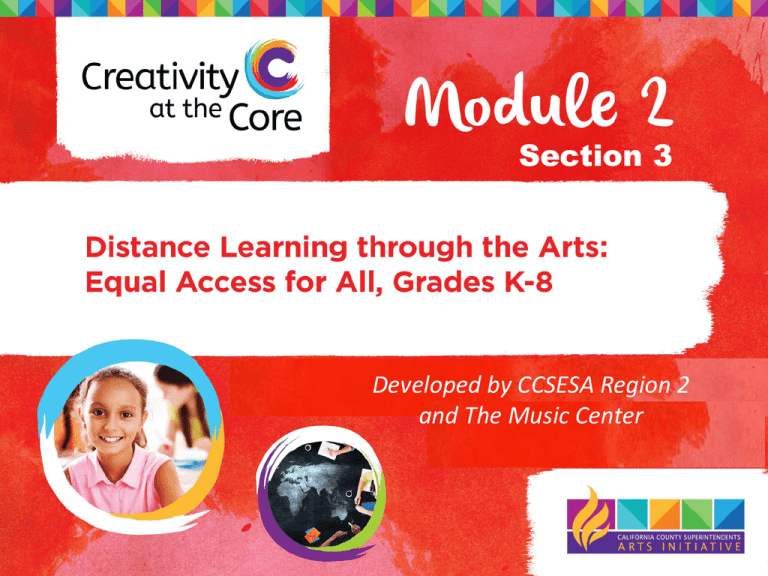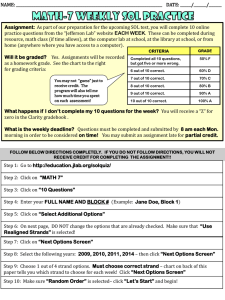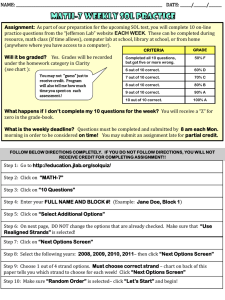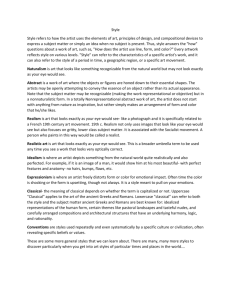Section 3 PowerPoint - CCSESA Arts Initiative
advertisement

Section 3 Developed by CCSESA Region 2 and The Music Center Norms • ENJOY and make the most of this time • Be CURIOUS and CREATIVE • Feel COMFORTABLE to ask questions • Be a TENACIOUS learner • Be Present -Please place technology in BUSINESS mode 2 Section 3: Artsource® Overview Leadership and Teacher Training Outcome: Explore how the Artsource® units can be resources for arts integration for K-8 school-wide or district-wide instruction Integration into Core Content Areas • The arts can stimulate involvement in many subjects by helping students relate to abstract concepts such as patterns, energy, cycles, sound, motion, space and time. Tell Me More about Art! • Artists create work within the physical laws of the universe, shaping and combining the elements in expressive ways. • Music, dance, theatre, literature, and visual arts reflect culture, points of view, and the period of time in which they are created. • The arts represent different forms of communication and provide tools for exploring possibilities and demonstrating ideas. • They enable students to express their own thoughts within artistic structures and help them to identify with universal human experiences. What is Artsource®? Artsource® is a Free Online Performing Arts Resource for Educators Artsource® brings the expressive world of the arts into classrooms and empowers teachers to: • Present artistic models in dance, music, and theatre to their students • Guide students through varied levels of standardsbased arts lessons • Examine and experience a broad spectrum of culturally diverse styles • Integrate the arts with other subject areas, such as Language Arts, Social Studies, History, and Science • Explore meaning through Universal Themes www.musiccenter.org/artsource What is the Format? Each Artsource® unit includes a short summary on the landing page that provides historical and cultural background on a selected artist and a description of the featured artwork. One or more Audio-Visual resources are central to each Artsource® unit. https://youtu.be/u-0KcUxnGCw One or more Audio-Visual resources are central to each Artsource® unit. The Artsource® curriculum unit is offered in both PDF and Flipbook formats. The Big Ideas Each Artsource® curriculum unit highlights: • A selected art form (identified in the top right corner) • The Style of Art • California Visual and Performing Arts Framework Component Strands • One or more Universal Themes highlighted as they relate to the selected work What is a Universal Theme? • Throughout time, artists have searched for answers, explored ideas, and expressed their own perspectives through their art. What are the commonalities? • Each artist has added something of their own creative insight to the collective pool of knowledge from which we all draw. • The Music Center has identified five Universal Themes which serve as the foundation of all 69 Artsource® units. Five Universal Themes Transformation refers to a change in the appearance, thinking or character of a person, animal, idea, situation, place or object. Enduring Values encompass the standards and principles which are considered important in life, such as love, aesthetics, justice, honor, spirituality and the search for truth. Freedom and Oppression centers on the struggle and balance of power between individuals and between groups of people. It includes concepts such as war and peace, master and slave, and dictatorship and democracy. The Power of Nature includes the entire natural world, its laws and its mysteries, as well as man’s relationship to it. The Human Family embraces all that is human, including emotions, dreams, the family structure, relationships, work, games, culture and history. Visual & Performing Arts Framework The California Visual and Performing Arts Framework Components are highlighted as they pertain to the selected work. VAPA Strands VISUAL AND PERFORMING ARTS CONTENT STANDARDS for CALIFORNIA PUBLIC SCHOOLS Pre-Kindergarten through Grade Twelve Content Standards in dance, music, theatre, and visual arts were adopted by the State Board of Education in January 2001. The standards guide school districts in developing comprehensive arts education programs at each grade level. ARTS CONTENT STANDARDS – COMPONENT STRANDS Component Strand 1: ARTISTIC PERCEPTION Processing, analyzing, and responding to sensory information through language and skills unique to each of the arts Component Strand 2: CREATIVE EXPRESSION Creating, performing, and participating in each of the arts Component Strand 3: HISTORICAL AND CULTURAL CONTEXT Understanding the historical contribution and cultural dimensions of each of the arts Component Strand 4: AESTHETIC VALUING Responding to, analyzing, and making judgments about works in each of the arts Component Strand 5: CONNECTIONS, RELATIONSHIPS AND APPLICATIONS Connecting and applying what is learned in each of the arts to the study of other art forms, subject areas, and careers Styles of Art The Styles of Art are highlighted as they pertain to the selected work. Five Styles of Art The Style of Art is the manner in which something is created, and does not refer to the content of the artwork itself. Traditional: Arts which are: • Involved with the beliefs or customs of a culture or group of people. • These arts are long-established and are passed from one generation to the next, often as a part of ritual and ceremony • In most traditional cultures, the arts are not seen as separate, but are integrated into different aspects of the community experience Classical: Arts which are traditional and standard in style that: • have a high quality that is recognized and unquestioned • feature artists who perform in this style and are identified and trained from an early age • represent many cultures in which the children of certain families carry on the classical traditions because it is the responsibility of their particular lineage to do so Styles of Art (continued) Contemporary: Works of art which are • within the 20th and 21st Century, • often reflecting changes of attitude within a specific culture • reflecting a work that is contemporary for a specific period of time and then becomes classic Experimental: works of art which • are highly innovative and sometimes controversial • break ground for revolutionary ideas • focus on artists are developing new concepts of form, introducing new techniques, or • employing an innovative process Multi-Media: works of art which involve • several different art forms in a collaborative way • style can include musicals, opera and performance art Artsource® Unit Introduction The introduction for each Artsource® unit contains: Artsource® Unit Introduction (continued) The introduction for each Artsource® unit contains: Artsource® Unit Introduction (continued) The introduction for each Artsource® unit contains: Artsource® Unit Introduction (continued) The introduction for each Artsource® unit contains: Artsource® Unit Introduction (continued) The introduction for each Artsource® unit contains: Artsource® Unit Introduction (continued) Each Artsource® unit also contains: • A photo of the artist • A quote from the artist • A map showing where the artist lived and worked “I am a weaver of words. Storytelling gives me the opportunity to intertwine the tradition of orally handed down stories of the Native American cultures with the contemporary experiences of my life and lives which continue to survive in the present age.” – Geri Keams Artsource® Unit Content Unit Components • Discussion Questions (after the video has been viewed) • Multidisciplinary Options • Sample Experiences (offering various levels that are scalable for K-8 instruction) • Fully Developed Sample Lessons (scalable for K-8 instruction) The Quillwork Girl - Beginning https://youtu.be/yrzosqccSDc Discussion Questions After watching the video of The Quillwork Girl: • If you could choose three adjectives to describe The Quillwork Girl, what would they be? • Everybody has a gift. The Quillwork Girl created beautiful clothes. What is your gift? • Who was the hero in The Quillwork Girl? Why do you think this was the hero? Multidisciplinary Options • Native Americans used a type of sign or notation called pictographs which were painted on tree bark or animal skins. Find examples to use for mural making, telling a simple story with selected symbols or images. • Many tribes wear headdresses and elaborate costume pieces in their rituals and ceremonies. Create masks and/or costumes patterned after those used by, for example, the Zuñi or Eskimo peoples. Incorporate them into a story theatre presentation. Refer to the Artsource® Unit, May Day Parade, Sample Lesson I. • Research and study the scientific theories about the migration of America’s first immigrants. How did scientists envision the geography of the world’s land mass at that time? How does it compare to the map or globe as we know it today? Sample Experiences LEVEL I • Tell one thing that happened in a myth or legend in the unit. • Draw a picture of one of the characters you liked. • Visit your school library to find a book of Native American stories and read one. • Make a sand painting based on traditional design. • Select several images from the American Indian symbols on page 6 of the unit. Create a story about them. Sample Experiences (continued) Sample Experiences (continued) LEVEL II • Dramatize a Native American legend. Have one person act as a narrator and have others pantomime the action. • Research the geographical locations of various Native American homelands. Mark the areas with flags on a map of the United States. • Read a collection of Trickster Tales about Hare, Coyote, or Raven. Sample Experiences (continued) Sample Experiences (continued) LEVEL III • Create a myth (such as “why the moon has phases”) explaining a mystery or phenomenon and transcribe it. • Compose song-poems based on Navajo ceremonial chants. • Be a storyteller and tell a Native American legend or myth in your own words. Sample Experiences (continued) Two examples of Navajo chants: 1)“My great corn plants, Among them I walk, I speak to them, They hold out their hands to me.” 2) “The voice of thunder Within the dark cloud, Again and again it sounds, The voice that beautifies the land.” Teacher Reflection Pair-Share Identify one strategy, resource, or section of content included in Artsource® that you can integrate into your lessons.








